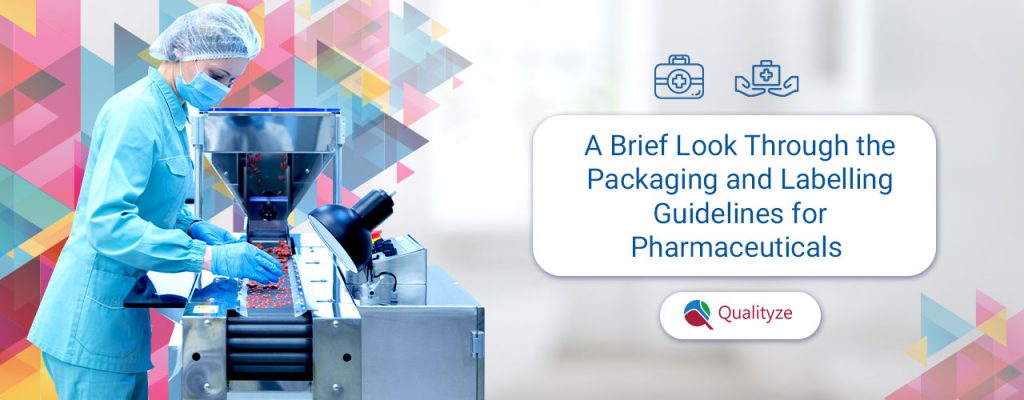Calculate your potential savings with our ROI Calculator
ROI CalculatorCalculate your potential savings with our ROI Calculator
ROI Calculator1 Why you should follow Packaging and Labelling guidelines for Pharmaceuticals?
1. Labelling Care
2. Show Product Information
3. Maintaining Label Format (For FDA)
4. Selection of Right Materials
5. Controlling and Inspecting Labels
7 Functions to be served by Packaging
1. Containment
2. Protection
3. Stability
4. Storage

Adhering to quality standards implies much more than maintaining the consistency of the product quality especially for the pharmaceutical manufacturers. They should consider other aspects as well including the packaging and labelling guidelines that the FDA has released to ensure that all the medical supplies reach safely to the patients.
The quality management system for pharmaceutical manufacturers should be powerful enough to manage all the aspects of the quality of medicines as well as their packaging and labelling information.
The quality guidelines for packaging and labelling is important to ensure that;
The most commonly used article to store the pharmaceuticals products safely is the container. The closure also plays an important role. It should not interact chemically or physically with the contents of the container, altering their quality. There are generally four kinds of containers preferable for the pharmaceutical industry:
In addition to the medicines, the machines and medical equipment require a special type of packaging and labeling facility to ensure appropriate usage of medical supplies for quality care of patients.
Let’s have a quick look at the proper labeling guidelines for the pharmaceutical and healthcare industry compiled from credible resources.
As per the guidelines shared by FDA, all the labels to be used in the pharmaceuticals and healthcare industry should be designed and applied well so that they stick to a place without losing the legibility in the varying environments including storage, regular use, and distribution.
It is the responsibility of the label manufacturer to ensure that the legibility of the print remains unaffected through the product life cycle. They should follow the compliance requirements for content as well as format.
Every pharmaceutical product requires some specific kind of information to be displayed on the product including the product name, ingredients, the facts table, warnings, directions of use, and the allergic reactions that it can cause.
Displaying the product information is one of the compliance requirements to be fulfilled by the pharmaceutical manufacturers to avoid any harmful reactions to the user or patients.
As we already discussed that FDA has specified an appropriate format for different pharmaceutical products including combination products, contraceptives, and other critical medicines. Some of the guidelines are –
Labelling materials are not strictly monitored in the pharmaceutical and healthcare products. You can use standard white paper to multi-layer labels based on the purpose you want the label to serve.
Considering the safety, you can be selective with the adhesives for the labels to avoid any other substance transfer to the medicines or devices.
In addition to the legibility, you must ensure that the information printed on the label is correct and consistent to comply with the industry standards. it ensures safety and liability too. You must discuss the same with the label manufacturer to keep quality processes in control.
However, you can use a supplier quality management software to ensure that you are getting only quality components from approved suppliers
There are four core functions to be served by packaging including:
It is one of the most basic functions that packaging serves for the medicinal products. You must consider the high-quality packaging to ensure zero product harm in manufacturing as well as the distribution system. The packaging material you use must not;
It is quite an important aspect to be considered when it comes to packaging the medicinal products. The packaging material must protect the main product from the influence of external factors such as sunlight, oxygen, moisture, contamination, or any physical damage.
The packaging material you use must be compatible with the pharmaceutical ingredients used in manufacturing the product. Hence, protecting the product and their integrity is one of the key functions that packaging must serve.
Related Article : 10 Challenges that Pharmaceuticals face for Equipment Maintenance
Guidelines on the stability of the pharmaceutical products is specified. Stability and compatibility generally fall in the initial level of research and development. The selection of the packaging material should be done after careful evaluation of possible interactions between the material and the content of the container.
The stability of the product matters to ensure that none of its properties change when it comes in contact with the packaging material. It may have a serious impact on the quality of the product.
The storage guidelines for the pharmaceutical goods are specified in the GMP guidelines to ensure safe storage for the specified time and temperature limit. For example – the normal instructions of storage that you will read on a medicinal product or drug is – “Store in a Dry and Cool Place” or “Don’t keep under direct sunlight” etc.
Again, it is not just about storage; it is about safe storage. Make sure the packaging material you use is effective enough for safe storage. Even if there are the certain specifications, share them clearly and concisely.
To ensure that all the packaging and labelling guidelines are properly used, you must establish a closed-loop quality management system that can help your teams to keep control of product and process quality while mitigating operational risks. It will help drive a culture of continuous improvement too.
One of the finest ways to ensure the compliant quality system is implementing the Qualityze EQMS suite. Built on the most powerful and secure cloud platform i.e. Salesforce, it offers great flexibility, scalability, and reliability to manage processes flawlessly even if you have geographically dispersed teams.
Let your pharmaceutical product quality control be managed through a powerful quality management system!